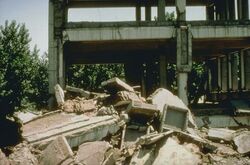
Buildings were flattened into rubble when the earthquake hit the 1976 Tangshan earthquake site.
Preparation[]
Over half a month before the earthquake struck, Wang Chengmin (汪成民) of the State Seismological Bureau (SSB) Analysis and Prediction Department had already concluded that the Tangshan region would be struck by a significant earthquake between July 22, 1976 and August 5, 1976 due to animal behavior and systemic phenomena like water rising in wells. Wang made an effort to publicise and spread the information to 60 people, despite it being a criminal offence . One of the people listening in Qinglong was the local official Wang Chunqing (王春青).
The event[]
The Tangshan earthquake, also known as the Great Tangshan earthquake was generated by the sudden slipping movement of 25-mile-long Tangshan Fault, which runs near the northern Tangshan on July 27, 1976. It hit in the early morning and lasted for about 14 to 16 seconds. The Chinese government official sources state a magnitude of 7.8 on the Richter magnitude scale, though some outside sources listed it as high as 8.2. It was followed by a major 7.1 magnitude aftershock some 16 hours later. Tangshan city, in Hebei province, was an industrial city with approximately 1,000,000 inhabitants at the time. The city lies on unstable alluvial soil. The earthquake devastated the city over an area of ~6.5 kilometers (4.0 mi) by ~8 kilometers (5.0 mi).
With 242,769 to 665,000 dead, making it the 2nd deadliest earthquake of modern history. A further circa ~164,000 people were recorded as being severely injured. The lower estimates are limited to Tangshan and exclude fatalities in the densely populated surrounding areas. It was the worst Chinese earthquake 1556 Shaanxi Earthquake, which killed ~830,000, on January 23, 1556. The 1923 Great Kantō earthquake, killed 143,000 in Tokyo in 1923.
The economic loss totaled to 10,000,000,000 yuan.
The aftermath[]
The Chinese government refused to accept international aid from the United Nations, and insisted on self-reliance, which worked, mostly due to the efforts of the Shanghai district authoraties. Sadly, The clinicly insaine group which became known as Gang of Four, only used it as political fodder in there ongoing fude with Deng Xiaoping and caired nothing for the victims' lives.
Mystic symbolism[]
The earthquake occurred between a series of political events involving the Communist Party of China, ultimately leading to the expulsion of the ruling Gang of Four by Mao's chosen successor, Hua Guofeng. In traditional Chinese thought, natural disasters are seen as a precursor of dynastic change.
The earthquake was preceded by the death of Zhou Enlai in the earlier months and followed by the death of Mao Zedong in that September. The political repercussions of the disaster and its aftermath contributed to the end of the Cultural Revolution.
Also see[]
Links[]
- http://www.wikiwand.com/en/1976_Tangshan_earthquake
- http://earthquake.usgs.gov/earthquakes/world/events/1976_07_27.php
- http://earthquake.usgs.gov/earthquakes/world/events/1976_07_27_eib.php
- http://history1900s.about.com/od/horribledisasters/a/tangshan.htm
- http://history1900s.about.com/od/horribledisasters/a/deadlyquakes.htm
- http://www.sciencedaily.com/terms/1976_tangshan_earthquake.htm
- http://www.wikiwand.com/en/List_of_natural_disasters_by_death_toll#/Earthquakes